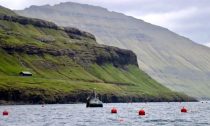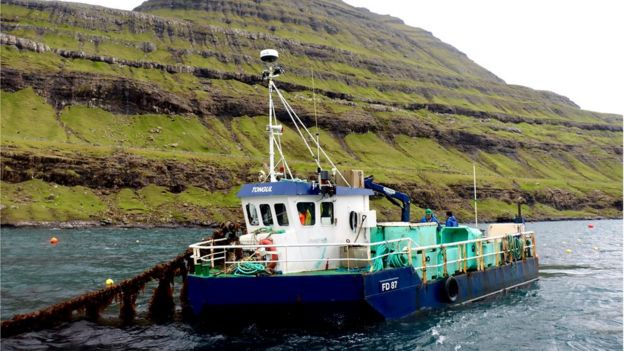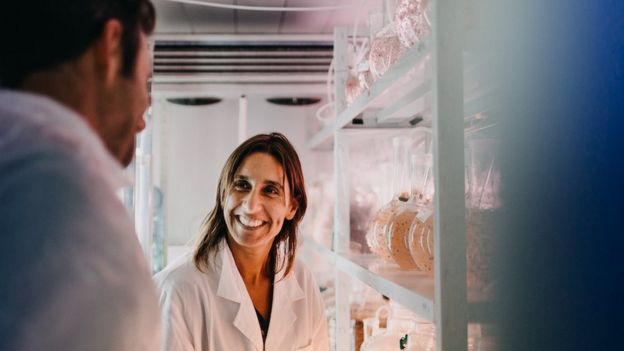
Sunshine has given way to wind and rain, as the motorboat chugs through a fjord in the Faroe Islands.
“Its a bit windy here,” says Olavur Gregarsen. “We’ll see how far we can get to the harvesting boat.”
We soon reach a sheltered spot where steep mountains are looking down on hundreds of buoys bobbing in the sea.
“They are holding up a horizontal line,” explains Mr Gregarsen, the managing director of Ocean Rainforest, a seaweed producer. “At every metre another line hangs down, and that’s where the seaweed grows.”
Breaking waves
Anchored to the sea floor, the cultivation rig consists of 50,000m (164,000ft) of underwater lattice-like ropes, designed to withstand rough sea conditions.
“The main structure is 10m down. That way we avoid the largest breaking waves,” he says.
Despite the Danish territory’s remote North Atlantic location, Mr Gregarsen says the deep, nutrient-rich, waters are well suited for growing seaweed, with a stable temperature of between 6C and 11C.

His firm is among a wave of seaweed farms that have sprung up in Europe and North America, spurred by a growing demand from the food industry and others.
“You have a biomass that can be used for food and feed, and replacing fossil-based products like packaging material from plastic,” he says.
Mechanisation
Seaweeds are fast-growing algae. They utilise energy from sunlight, and take up nutrients and carbon dioxide from the seawater. Scientists suggest seaweed could help fight climate change and offset carbon emissions.
Ocean Rainforest recently won funding from the US Department of Energy to build a similar system in California, where there’s interest in developing industrialised seaweed production for future biofuels.
Aboard the harvesting boat the skipper controls a mechanical arm that lifts lines from the water. The seaweed is chopped free, filling up containers. It’s quick but messy work. The lines are then left to regrow. This year around 200 tonnes will be harvested.
But the company is scaling up, and plans to double its capacity this year. It isn’t making money just yet, but expects to soon, Mr Gregarsen tells me.
“We can see how we can mechanise this, how we can make this a really large-scale efficient activity,” he says.
“There are not many companies that do this as a profitable business, if any.”
Cosmetics and medicines
Seaweed needs to be processed quickly. At a small plant in the Faroese village of Kaldbak, machines clean the harvest. Some is dried and supplied to food manufacturers. The rest is fermented and shipped to animal feed producers.
Most farmed seaweed is consumed in food, but extracts are used in a wide variety of products. Whether it is toothpaste, cosmetics, medicines or pet food, these often contain hydrocolloids derived from seaweed, which have gelling or thickening properties.
And more products are coming, with other firms working on textiles and plastic alternatives, including biodegradable packaging, water capsules, and drinking straws.
Seaweed production has boomed. Between 2005 and 2015 volumes doubled, surpassing 30 million tonnes annually, reports the UN’s Food and Agriculture Organization. It is a business worth more than $6bn (£5bn) worldwide.
Yet only a fraction of cultivation happens outside Asia, where farming is a long-established, but mostly labour-intensive activity.
‘A lot of effort’
“The labour cost is really high in Europe, so that’s one major part of it,” explains Annette Bruhn, who is a senior scientist at Aarhus University in Denmark.
“A lot of effort needs to be put into mechanisation and upscaling.”
To make farming economical, she says “the yield needs to go up and the cost needs to go down”.
But farming systems aren’t easily replicated. “Different areas in different waters, all require modifications. There’s not one solution that can be expected to fit all,” says Ms Bruhn.

However, she is hopeful, and says there are “many areas where you can have breakthroughs”.
That is what innovators like Sintef are trying to do. The Norwegian scientific research group is working on new technologies to streamline farming.
“Now most of the seaweed is used for food, but in the future we want to use it for fish feed, fertilisers, biogas. We need large volumes and we need to produce much faster,” says research scientist Silje Forbord.
Dry lab
Prototype machines such as the “seaweed spinner” automatically wrap spools of seedling-carrying threads onto lines, ready for deployment at sea.
Another concept, SPoke (Standardized Production of Kelp), consists of circular farm modules where seaweed grows from lines radiating outwards. It is designed so a robot can move along the wheel-like spokes – either attaching threads carrying juvenile seaweed or harvesting it.
“We’ve built one arm with a robot going back and forth. That has been tested in a dry lab,” explains Ms Forbord, but more investment will be needed.
In a series of ponds and tanks in northern Portugal, AlgaPlus is cultivating seaweed inland.
“It’s a much more controlled environment,” says managing director Helena Abreu, who thinks there are more advantages compared to farming offshore.
“We maintain the temperature and everything inside the tanks,” she says. “You have year-round production.”

Ms Abreu co-founded the firm after spending five years as a marine biologist in the Azores. Small, high-value seaweeds are produced for food companies, cosmetics makers and high-end restaurants.
Innovation
Seawater from a coastal lagoon flows into fish ponds. It is then pumped through a filtration system into tanks growing seaweed. There’s also a hatchery breeding the seedlings.
“We had to innovate from scratch,” she says.
These waters are rich in nitrogen, which the algae take up, mimicking nature. “We don’t need to use any additives, no fertiliser. We use water from the fish to grow our seaweed,” she says.
Ms Abreu doesn’t think availability of land is a limiting factor. Former salt works and fish farms could be repurposed, she says, pointing out there are hectares of availability in Portugal, France, Italy, Greece and Turkey.
Onshore seaweed farming takes place in Canada and South Africa too. Micro-algae are also grown in tank systems.
But there are other challenges.
“The main bottleneck is energy cost. Working with tanks you need the pumping and the aeration to keep the water moving,” says Ms Abreu.
The firm can’t survive on sales alone just yet. But Ms Abreu is convinced that the seaweed market will continue to grow.
“It’s a huge trend,” she says. “Every year there’s more and more companies. There are newcomers in all steps of the value chain.”












Social Profiles